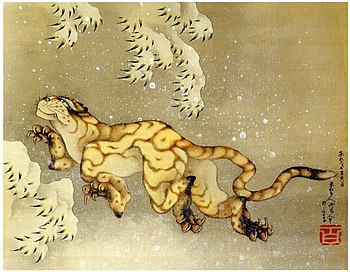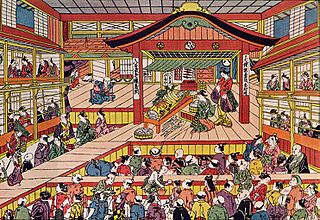
Ukiyo-e is a genre of Japanese art that flourished from the 17th through 19th centuries. Its artists produced woodblock prints and paintings of such subjects as female beauties; kabuki actors and sumo wrestlers; scenes from history and folk tales; travel scenes and landscapes; flora and fauna; and erotica. The term ukiyo-e translates as 'picture[s] of the floating world'.

Katsushika Hokusai, known simply as Hokusai, was a Japanese ukiyo-e artist of the Edo period, active as a painter and printmaker. He is best known for the woodblock print series Thirty-Six Views of Mount Fuji, which includes the iconic print The Great Wave off Kanagawa. Hokusai was instrumental in developing ukiyo-e from a style of portraiture largely focused on courtesans and actors into a much broader style of art that focused on landscapes, plants, and animals. His works are thought to have had a significant influence on Vincent van Gogh and Claude Monet during the wave of Japonisme that spread across Europe in the late 19th century.
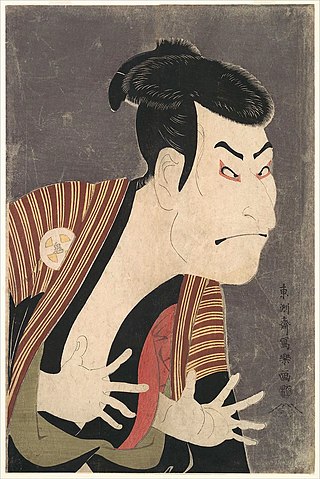
Tōshūsai Sharaku was a Japanese ukiyo-e print designer, known for his portraits of kabuki actors. Neither his true name nor the dates of his birth or death are known. His active career as a woodblock artist spanned ten months; his prolific work met disapproval and his output came to an end as suddenly and mysteriously as it had begun. His work has come to be considered some of the greatest in the ukiyo-e genre.
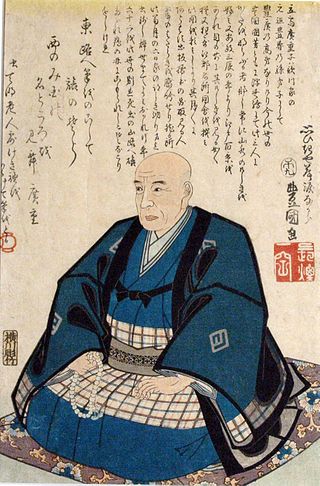
Utagawa Hiroshige, born Andō Tokutarō, was a Japanese ukiyo-e artist, considered the last great master of that tradition.

Kawanabe Kyōsai was a Japanese painter and caricaturist. In the words of art historian Timothy Clarke, "an individualist and an independent, perhaps the last virtuoso in traditional Japanese painting".
Okumura Masanobu was a Japanese print designer, book publisher, and painter. He also illustrated novelettes and in his early years wrote some fiction. At first his work adhered to the Torii school, but later drifted beyond that. He is a figure in the formative era of ukiyo-e doing early works on actors and bijin-ga.

Utagawa Toyohiro, birth name Okajima Tōjiro (1773–1828), was a Japanese ukiyo-e artist and painter. He was a member of the Utagawa school and studied under Utagawa Toyoharu, the school's founder. His works include a number of ukiyo-e landscape series, as well as many depictions of the daily activities in the Yoshiwara entertainment quarter; many of his stylistic features paved the way for Hokusai and Hiroshige, as well as producing an important series of ukiyo-e triptychs in collaboration with Toyokuni, and numerous book and e-hon illustrations, which occupied him in his later years.

Shunshō Katsukawa was a Japanese painter and printmaker in the ukiyo-e style, and the leading artist of the Katsukawa school. Shunshō studied under Miyagawa Shunsui, son and student of Miyagawa Chōshun, both equally famous and talented ukiyo-e artists. Shunshō is best known for introducing a new form of yakusha-e, prints depicting Kabuki actors. However, his bijin-ga paintings, while less famous, are said by some scholars to be "the best in the second half of the [18th] century".

Thirty-six Views of Mount Fuji is a series of landscape prints by the Japanese ukiyo-e artist Hokusai (1760–1849). The series depicts Mount Fuji from different locations and in various seasons and weather conditions. The immediate success of the publication led to another ten prints being added to the series.
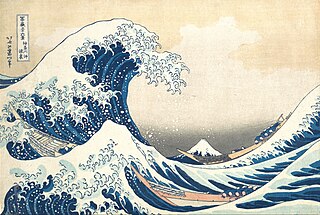
The Great Wave off Kanagawa is a woodblock print by Japanese ukiyo-e artist Hokusai, created in late 1831 during the Edo period of Japanese history. The print depicts three boats moving through a storm-tossed sea, with a large, cresting wave forming a spiral in the centre and Mount Fuji visible in the background.
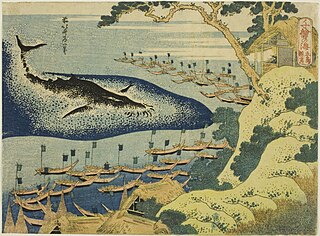
Oceans of Wisdom is a chūban yoko-e sized woodblock print series by the Japanese artist Hokusai. The ten fishing-themed prints comprise one of Hokusai's rarest sets. Published by Moriya Jihei, it seems to have been issued around 1832–1834 and publication of the prints ceased abruptly. Some preparatory drawings are extant for prints that were never made.

Fine Wind, Clear Morning, also known as Red Fuji, is a woodblock print by Japanese artist Hokusai (1760–1849), part of his Thirty-six Views of Mount Fuji series, dating from c. 1830 to 1832. The work has been described as "one of the simplest and at the same time one of the most outstanding of all Japanese prints".
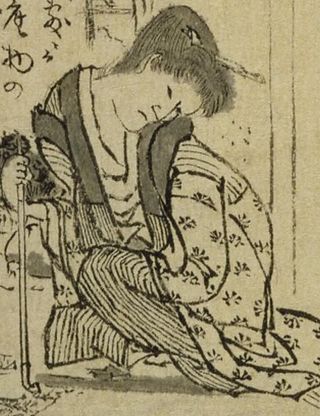
Katsushika Ōi, also known as Ei (栄) or Ei-jo, was a Japanese Ukiyo-e artist of the early 19th century Edo period. She was a daughter of Hokusai from his second wife. Ōi was an accomplished painter who also worked as a production assistant to her father.

Totoya Hokkei was a Japanese artist best known for his prints in the ukiyo-e style. Hokkei was one of Hokusai's first and best-known students and worked in a variety of styles and genres and produced a large body of work in prints, book illustrations, and paintings. His work also appeared under the art names Aoigazono (葵園), Aoigaoka (葵岡) and Kyōsai (拱斎).

A Tour of the Waterfalls of the Provinces is a series of landscape woodblock prints by the Japanese ukiyo-e artist Hokusai.

Nishimuraya Yohachi was one of the leading publishers of woodblock prints in late 18th-century Japan. He founded the Nishimuraya Yohachi publishing house, also known as Nishiyo (西与), which operated in Nihonbashi's Bakurochō Nichōme under the shop name Eijudō. The firm's exact dates are unclear, but many art historians date its activity to between c. 1751 and 1860.

Kajikazawa in Kai Province is a woodblock print by the Japanese ukiyo-e artist Hokusai.

Thunderstorm Beneath the Summit, also known as Rainstorm Beneath the Summit, or sometimes Black Fuji is a woodcut print by the Japanese ukiyo-e master Hokusai (1760–1849). It is one of the most famous prints from his celebrated Thirty-six Views of Mount Fuji series, published c. 1830–1832.

One Hundred Views of Mount Fuji is a series of three illustrated books by Japanese ukiyo-e artist Hokusai. It is considered one of Japan's most exceptional illustrated books (e-hon), and alongside the Hokusai Manga, the most influential in the West. The first two volumes were published in 1834 and 1835, shortly after completion of his seminal Thirty-six Views of Mount Fuji, with a third released in the late 1840s.
